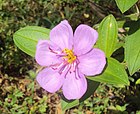Note: This is a project under development. The articles on this wiki are just being initiated and broadly incomplete. You can Help creating new pages.
Melastoma malabathricum
Melastoma malabathricum, known also as Malabar melastome, Indian rhododendron, Singapore rhododendron, planter's rhododendron and senduduk, is a flowering plant in the family Melastomataceae.
Uses
Parts Used
Chemical Composition
Various phytochemical groups and constituents have been identified in M. malabathricum since 1968 and are strongly associated with its ethnomedicinal values. Earlier study by Lowry showed the presence of ellagic acid and anthocyanin (e.g., malvidin-3,5-diglucoside) in the methanol extract of M. malabathricum barks (MMMBk) and aqueous extract of M. malabathricum flowers (AMMFw), respectively. Meanwhile, Lowry also reported the presence of anthocyanins (e.g., cyanidin- (Cy-) 3-glucoside and Cy-3,5-diglucoside) in the water extract of M. malabathricum fruits (WMMFr). Manzoor-I-Khuda et al. reported the isolation of β-sitosterol and a triterpenoid designated as melastomic acid (5-hydroxylup-20(29)-en-28-oic acid) from the ethanolic extract of M. malabathricum roots (EMMR). Dinda and Saha reported the isolation of 1-octyl docosanoate and 11-methyl-1-tricontanol while Dinda and Saha [45] reported the presence of fatty acids and sterols. Das and Kotoky reported the isolation of a new aliphatic constituent, namely, 32-methyl-1-tritriacontanol, together with ursolic acid, p-hydroxybenzoic acid and gallic acid, and kaempferol from the leaves and flowers of M. malabathricum. Compounds like kaempferol-3-O-β-D-xyloside, quercetin-3-O-α-L-rhamnosyl-(1→2)-β-D-galactoside, flavan-3-ol, 4′-methylpeonidin-7-O-β-D-glucoside, anthocyanins, and tannins have also been isolated from the aerial part of M. malabathricum [1]
Common names
| Language | Common name |
|---|---|
| Kannada | |
| Hindi | |
| Malayalam | Kalathi,Kadali,Athirani,Thodukkara,Kalampotti |
| Tamil | |
| Telugu | |
| Marathi | NA |
| Gujarathi | NA |
| Punjabi | NA |
| Kashmiri | NA |
| Sanskrit | |
| English | Malabar Melastome, Indian-rhododendron |
Properties
Reference: Dravya - Substance, Rasa - Taste, Guna - Qualities, Veerya - Potency, Vipaka - Post-digesion effect, Karma - Pharmacological activity, Prabhava - Therepeutics.
Dravya
Rasa
Guna
Veerya
Vipaka
Karma
Prabhava
Habit
Identification
Leaf
| Kind | Shape | Feature |
|---|---|---|
| Simple | Alternate | The leaves are light green and feathery with a bipinnate pattern |
Flower
| Type | Size | Color and composition | Stamen | More information |
|---|---|---|---|---|
| Unisexual | 1 inch | Light blue | 5 | Flowers Season is June - August |
Other features
List of Ayurvedic medicine in which the herb is used
- Vishatinduka Taila as root juice extract
Where to get the saplings
Mode of Propagation
How to plant/cultivate
Shrubs to 1.3 m tall; stem densely covered with paleaceous pectinate hairs. Leaves 4-11 x 1.5-4 cm, elliptic-oblong, base attenuate, apex acute, upper surface prominently lineolate; lower surface tomentose, 5-ribbed, drying dull-greenish; petiole to 1.5 cm long. Flowers solitary or few in rather dense clusters, c. 5 cm across; bracts 1.2-2 x 1-1.4 cm, boat-shaped, densely paleaceous hairy. Calyx tube 0.7-1 cm long, campanulate; lobes 5, 5-7 x 4-5 mm, ovate-lanceolate, densely paleaceous hairy. Petals 5, reddish purple, 1.5-2 x 0.7 - 1 cm, obovate. Stamens 10, alternating ones large and small; anthers dimorphic, dehiscence by apical pores. Ovary ovoid, 5-locular; ovules many; style simple. Capsules 1-1.5 x 0.8-1 cm, ovoid, irregularly dehiscent. Seeds many, minute. [3]
Commonly seen growing in areas
Photo Gallery
References
External Links
- Ayurvedic Herbs known to be helpful to treat Treat diarrhoea
- Ayurvedic Herbs known to be helpful to treat Dysentery
- Ayurvedic Herbs known to be helpful to treat Hemorrhoids
- Ayurvedic Herbs known to be helpful to treat cuts and wounds
- Ayurvedic Herbs known to be helpful to treat toothache, and stomachache
- Herbs with leaves used in medicine
- Herbs with shoots used in medicine
- Herbs with barks used in medicine
- Herbs with seeds, and roots used in medicine
- Herbs with common name in Malayalam
- Herbs with common name in English
- Habit - Herb
- Index of Plants which can be propagated by roots
- Herbs that are commonly seen in the region of Tall grasslands
- Herbs that are commonly seen in the region of Meadows
- Herbs



